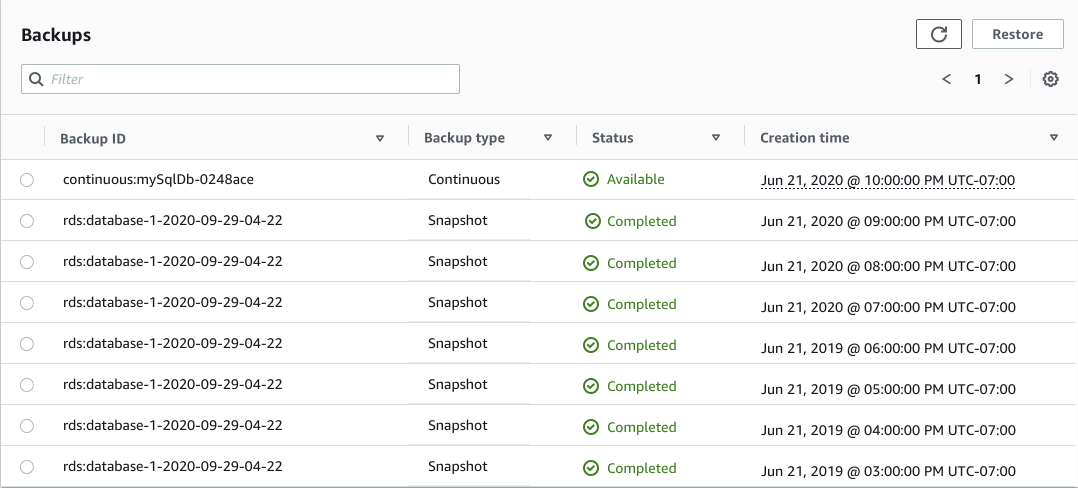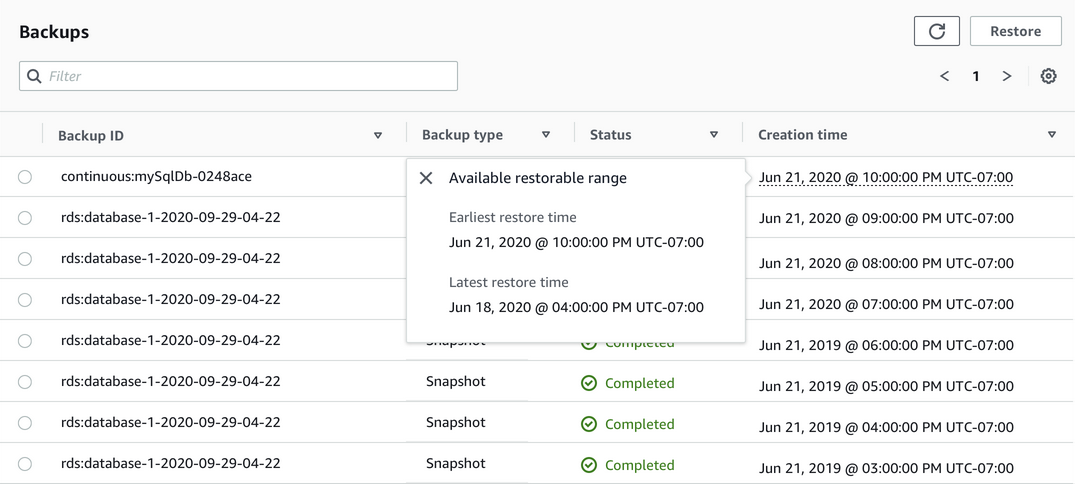AWS Storage Blog
Point-in-time recovery and continuous backup for Amazon RDS with AWS Backup
Today, AWS Backup is announcing support for continuous backup and point-in-time recovery (PITR) of Amazon Relational Database Service (Amazon RDS). This feature enables customers to recover Amazon RDS backup data from a specified time within their retention period. With this feature, database and backup administrators are able to reduce their recovery point objective (RPO) to 5 minutes or under, directly from the AWS Backup console.
AWS Backup is a cost-effective, fully managed, policy-based service that simplifies protecting and backing up your data at scale. AWS Backup helps you support your regulatory compliance obligations and meet your business continuity goals. Together with AWS Organizations, AWS Backup enables you to centrally deploy data protection (backup) policies to configure, manage, and govern backup activity across your organization’s AWS accounts and resources, including:
- Amazon EC2 instances
- Amazon EBS volumes
- Amazon RDS databases (including Amazon Aurora clusters)
- Amazon DynamoDB tables
- Amazon EFS
- Amazon FSx for Lustre
- Amazon FSx for Windows File Server
- AWS Storage Gateway volumes
Today’s launch enables you to initiate continuous backup directly from backup plans in the AWS Backup console, without needing to switch back and forth from the Amazon RDS console. This further streamlines administrator effort when managing backups. Previously, administrators had to manage continuous backup and PITR plans in the Amazon RDS console, database by database. Now, customers no longer need to coordinate backup policies between AWS Backup and Amazon RDS to achieve a particular RPO. In addition, customers no longer need to coordinate backup windows to leverage both snapshot-based Amazon RDS backups (which were available when AWS Backup launched in January 2019) and continuous backups. Note that as of this announcement, this feature does not support continuous backup and point-in-time recovery (PITR) for Amazon Aurora clusters.
In this post, I discuss how administrators can leverage AWS Backup for all their Amazon RDS backup operations. Backup administrators can configure a single backup plan for backup configuration consistency, which means less time toggling between Amazon RDS and AWS Backup consoles to manage database backups. Customers using AWS Organizations can also leverage cross-account monitoring and management, and can orchestrate cross-Region and cross-account copy from their central management account, further simplifying compliance audits. AWS Backup support for Amazon RDS simplifies backing up your databases tremendously, enabling you to focus less time and money on backup management and compliance, and more on core competencies.
Amazon RDS continuous backup and PITR tutorial
First, login to the AWS Management Console. Using the search bar at the top of the console, type ‘AWS Backup’ to find the AWS Backup console. Then, select the AWS Backup console search result in order to navigate to the AWS Backup console.

Next, make sure that you have enabled Amazon RDS as a service that you want AWS Backup to protect. On the left pane, under the My account section, select Settings. Then, navigate to the Service opt-in section and ensure that you have enabled Amazon RDS; confirm that by checking under the Status column, it will show as Enabled. If RDS is showing as Disabled, then select the Configure resources button and select the toggle button to enable RDS.

A backup vault is required for a backup plan to be used as the backup repository. If you already have a backup vault created, you can use that existing vault. If you use the Amazon RDS continuous backup and point-in-time recovery feature directly from the AWS Backup console for the first time, a default backup vault will be created for you to store your backups. If you’d rather use the CLI to create a backup vault when using AWS Backup, view the AWS Backup documentation on creating a backup vault.
If a backup plan for Amazon RDS exists, you can modify the existing backup plan to include continuous backups. This process is done by either creating a new backup rule and enabling point-in-time recovery, or by modifying an existing backup rule. As continuous backups have a maximum retention of 35 days, you also need to indicate the retention period (up to 35 days) for your Amazon RDS continuous backups. Remember, this setting is independent of your snapshot-based Amazon RDS backups.
For this exercise, we are creating a new backup plan. Click on Backup plans on the left pane and then select the Create Backup plan button on the right.

Next, select the Build a new plan radio button and enter your Backup plan name.

Then, navigate to the Backup rule configuration section. Select the box next to Enable continuous backup for supported resources. As of the publishing of this blog post, point-in-time recovery is only supported for Amazon RDS resources only (not including Amazon Aurora clusters). When support is expanded, resources assigned to your backup plan with point-in-time recovery capabilities will inherit your configuration automatically. For information on Amazon RDS point-in-time recovery, view the Amazon RDS documentation.
Navigate further down the screen and select a retention period up to a maximum of 35 days; afterward, click Create Plan.

After creating your backup plan, locate the continuous backup in your backups, as indicated under the Backup type column. The backup should show as Available upon completion of the first continuous backup, indicating that PITR is available.

Select the date under Creation time to view your Available restorable range, which is in-between Earliest restore time and Latest restore time.

To recover your Amazon RDS database within AWS Backup, first select the backup, then select the Restore button in the upper right. Restore your Amazon RDS instance within your backup retention period. Restoring your data creates a new Amazon RDS instance. Specify the backup you want to recover, and enter your Amazon RDS instance configuration as required. Then, click Restore to point in time.

Upon completion of the restore, navigate to the Amazon RDS console to access the created database instance.
Conclusion
In this post, I reviewed the continuous backup and point-in-time recovery (PITR) feature that is available from within AWS Backup for Amazon RDS. We detailed how to configure AWS Backup to provide centralized management of Amazon RDS backups. By implementing continuous backup within AWS Backup, customers no longer have to manage their RDS backups across multiple services. This greatly reduces management overhead, enabling administrators to focus on other projects and core competencies, in addition to ensuring compliance and data integrity.
Thank you for reading this blog post. If you have any comments or questions, don’t hesitate to leave them in the comments section.